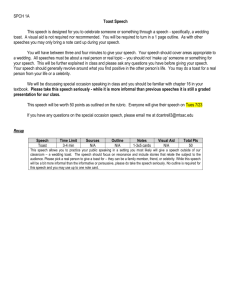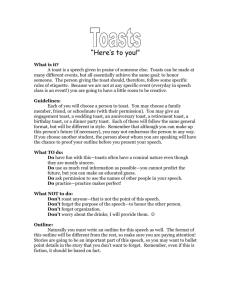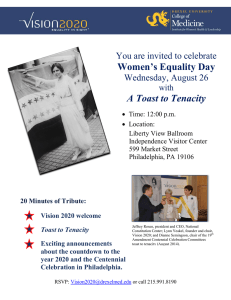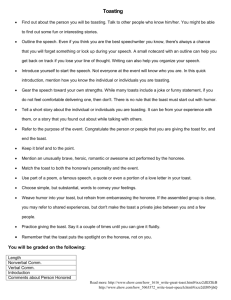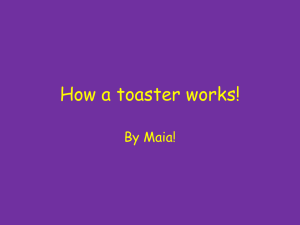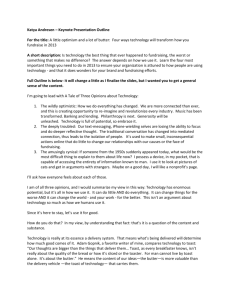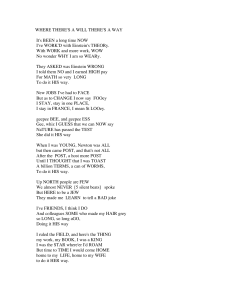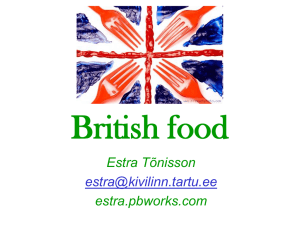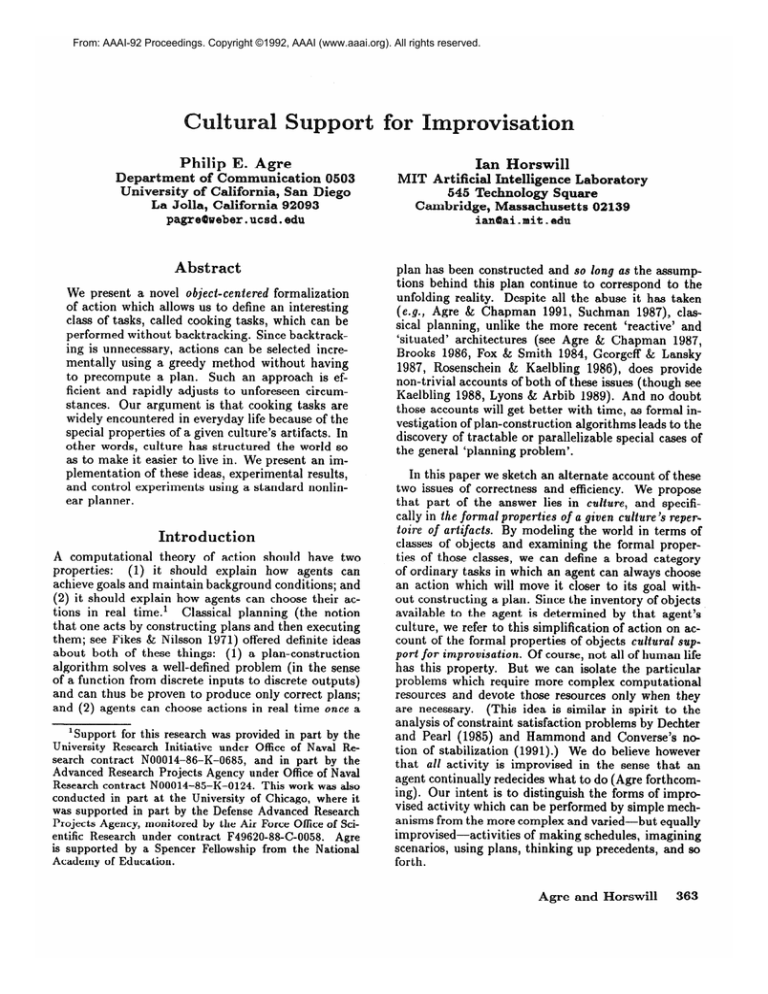
From: AAAI-92 Proceedings. Copyright ©1992, AAAI (www.aaai.org). All rights reserved.
Philip E. Agre
mt of communicatio
y of Califoruia, San
La Jolla, California 92093
pagrs@weber.ucsd.edu
Abstract
We present a novel object-centered
formalization
of action which allows us to define an interesting
class of tasks, called cooking tasks, which can be
performed without backtracking. Since backtracking is unnecessary, actions can be selected incrementally using a greedy method without having
to precompute a plan. Such an approach is efficient and rapidly adjusts to unforeseen circumstances. Our argument is that cooking tasks are
widely encountered in everyday life because of the
special properties of a given culture’s artifacts. In
other words, culture has structured the world so
as to make it easier to live in. We present an implementation of these ideas, experimental results,
and control experiments using a standard nonlinear planner.
Introduction
A computational theory of action should have two
properties:
(1) it should explain how agents can
achieve goals and maintain background conditions; and
(2) it should ex pl ain how agents can choose their acClassical planning (the notion
tions in real time.l
that one acts by constructing plans and then executing
them; see Fikes & Nilsson 1971) offered definite ideas
about both of these things: (1) a plan-construction
algorithm solves a well-defined problem (in the sense
of a function from discrete inputs to discrete outputs)
and can thus be proven to produce only correct plans;
and (2) agents can choose actions in real time once a
‘Support for this research was provided in part by the
University Research Initiative under Office of Naval Research contract N00014-86-K-0685,
and in part by the
Advanced Research Projects Agency under Office of Naval
Research contract N00014-85-K-0124.
This work was also
conducted in part at the University of Chicago, where it
was supported in part by the Defense Advanced Research
Projects Agency, monitored by the Air Force Office of Scientific Research under contract F49620-88-C-0058.
Agre
is supported by a Spencer Fellowship from the National
Academy of Education.
Ian Horswill
MIT Artificial
telligence Laboratory
545 Technology Square
Cambridge, Massachusetts 02139
ian@ai.mit.edu
plan has been constructed and so long as the assumptions behind this plan continue to correspond to the
unfolding reality. Despite all the abuse it has taken
(e.g., Agre & Chapman 1991, Suchman 1987), classical planning, unlike the more recent ‘reactive’ and
‘situated’ architectures (see Agre & Chapman 1987,
Brooks 1986, Fox & Smith 1984, Georgeff & Lansky
1987, Rosenschein & Maelbling 1986), does provide
non-trivial accounts of both of these issues (though see
Kaelbling 1988, Lyons & Arbib 1989). And no doubt
those accounts will get better with time, as formal investigation of plan-construction algorithms leads to the
discovery of tractable or parallelizable special cases of
the general ‘planning problem’.
In this paper we sketch an alternate account of these
two issues of correctness and efficiency. We propose
that part of the answer lies in culture, and specifically in the formal properties of a given culture’s repertoire of artifacts. By modeling the world in terms of
classes of objects and examining the formal properties of those classes, we can define a broad category
of ordinary tasks in which an agent can always choose
an action which will move it closer to its goal without constructing a plan. Since the inventory of objects
available to the agent is determined by that agent’s
culture, we refer to this simplification of action on account of the formal properties of objects cultural support for improvisation.
Of course, not all of human life
has this property. But we can isolate the particular
problems which require more complex computational
resources and devote those resources only when they
are necessary. (This idea is similar in spirit to the
analysis of constraint satisfaction problems by Dechter
and Pearl (1985) and Mammond and Converse’s notion of stabilization (1991).) We do believe however
that all activity is improvised in the sense that an
agent continually redecides what to do (Agre forthcoming). Our intent is to distinguish the forms of improvised activity which can be performed by simple mechanisms from the more complex and varied-but equally
improvised-activities
of making schedules, imagining
scenarios, using plans, thinking up precedents, and so
forth.
Agre and Horswill
363
This paper is organized as follows. First we introduce a greatly simplified formalization of artifacts, materials, and actions involving these things. We then define ‘cooking tasks’, which are tasks which only involve
objects in certain classes and goals of certain types. We
demonstrate that cooking tasks can be performed in a
‘greedy’ fashion. We then sketch some extensions to
the simple model which broaden the model’s coverage
and are used by the program in the next section. This
program, called Toast, implements an elaboration of
this scheme and gives an example of it in action. We
conclude by suggesting some of the wider consequences
of this general type of research.
Ontology
of Cooking
Tasks
This section sketches a formal model of objects, actions, and tasks. Due to space restrictions, we have
greatly simplified the model, which as a result cannot
quite express everything that goes on in Toast. A later
section discusses some of the issues that this version of
the formalism leaves out. Note that the formalism is
for the purpose of analyzing interactions between the
agent and its environment; it does not necessarily describe any structures in the agent’s head.
Let us characterize objects in the world according to
the roles they play in customary routine activities. A
given object type (or type for short) will be characterized by a state graph, which is a finite labeled directed
graph. The nodes in this graph are called states and
the label on the arcs are called operations.
An opin the sense that it
eration can be non-deterministic
labels several arcs leading from the same state. An
object instance (or instance for short-we
will speak of
‘objects’ when it’s clear whether we mean types or instances) has an associated object type. A world state
is a finite set of instances and a mapping from each of
these instances to a state in its type’s state graph. A
history is a function from natural numbers (representing ‘time’) to world states. A history thus follows a set
of instances through a series of changes. (Toast can
create and destroy objects but the simplified formal
model here cannot.)
An action type (or action for short) consists of a finite sequence of pairs, each consisting of an object type
and an operation from that type’s state graph. An action instance consists of an action type and a sequence
of object instances, each of the appropriate type and
current state. For now we assume that only one action
takes place at a time, so that an action instance determines a (partial) function from world states to world
states, defined in the obvious way. A history is thus
determined by an initial world state and a sequence of
action instances.
Let a task consist of a finite set of object types called
an inventory, an initial world state, and a finite set of
goals, each of which consists of an object type and a
state from that type’s graph. A goal is satisfied in
a given world state if that world state includes some
364
Planning
instance of the indicated type that is in the indicated
state. (So one cannot assert that two instances of a
given type must be in a given state.)
So far these definitions are unexceptional.
All of
the complexity problems of classical planning (Chapman 1987) apply to this scheme as well. One cure for
complexity problems is the discovery of additional constraint in the task. The claim we make for our scheme
is that it allows us to define one important source of
complexity-ameliorating constraint in a natural way,
as follows.
Let us categorize object types according to the properties of their state graphs. We will refer to a given category of types as an object ciluss(or class for short). We
will find that certain classes have advantageous computational properties. We will define a particular class
of tasks, coo&g tasks, whose entire inventory of object
types falls into two classes: tools and materials.
First, let us say that a given action type is focused
if it only involves a single object, that is if it only
consists of a single operation. An operation is focused
if it is part of some focused action. Let us refer to
a state in a given type’s state graph as free if it can
be reached from any other state in that graph using
only focused operations. A tool, then, is an object
which possesses at least one free state. Each tool will
have a distinguished free state, called its normal state,
the point of which will become clear presently. (One
common normal state is “clean and dry.“)
The notion of a material is defined relative to a given
set of tools. A tool action is an action that involves
some number of tools (though typically one), and possibly one object which is not a tool; a normal tool action is a tool action in which the operations that apply
to tools require them to be in their normal states. A
material is an object whose state graph is acyclic and
has a distinguished raw state, from which all its other
states can be reached by means of operations found
in normal tool actions. (Of course, a material might
have all manner of other operations in its state graph
as well.)
A cooking task, then, is a task whose inventory consists of tools and materials. These classes, together
with a third class used by Toast, containers, cover the
vast majority of objects found in the average kitchen.
There is thus some reason to believe that the formalism bears some relation to the computational issues involved in actual cooking. Cooking is an attractive domain (compare Hammond, Converse, & Martin 1990,
Lansky & Fogelsong 1987) because it is fairly complicated but still routine, has fairly well-defined properties but regularly admits of uncertainty and surprise,
and has plainly been organized in customary ways to
allow action to be driven in large part by vision (compare Agre & Chapman 1987, Ballard 1991, Larkin
1989). On the other hand, our simple formalization
of cooking does not approach the true complexity of
cooking and kitchens (Hardyment 1988), or of artifacts
(Forty 1986, Norman 1988), as cultural phenomena.
On the other hand, these abstract ‘cooking tasks’ are
not limited to the preparation of food; they are likely
to be found in any activity involving the same general
classes of objects. No doubt each activity will require
its own extensions to the crude model we have outlined so far. The general strategy, though, is the same:
relating the formal properties of artifacts to the computational demands of improvised action.
This object-centered model of action is similar to the
conventional state-space model in that both of them
model potential actions using directed graphs. Given
a task in our model, one could construct a conventional
state space for it by computing the graph-theoretic
product of all the state graphs for each object instance.
This graph would, of course, be extraordinarily complicated. The object-centered model thus makes explicit
a great deal of formal structure that the conventional
model leaves implicit in the state graph.
OW
Cook
This section describes the process of solving a cooking task and sketches the design of an agent that can
do so efficiently. The general idea is that the agent is
in the kitchen, standing adjacent to the countertops
and stove and looking down at them. We assume that
the agent can readily detect the states of all visible
objects. The agent achieves its goals by using normal tool actions to push materials through their state
graphs along certain customary trajectories; and it uses
focused actions to get tools into normal states. The algorithm thus depends on a culturally evolved abstruction (Anderson & Farley 1988, Knoblock 1989) that
minimizes interactions among the actions in cooking
tasks. This section’s algorithm (unlike that of Toast)
does not clean its tools when it is done; this requires a
notion of ‘background conditions’ (see below).
The algorithm requires that the agent’s machinery
come with an action table for each material type that
maps a state in that material’s state graph and a goal
state to normal tool actions (if one exists) which can
convert instances of that material to the next state
along its trajectory toward goal state. (These tables
are not plans. They do, however, resemble STRIPS
triangle tables (Fikes and Nilsson 1971). They also resemble GPS difference tables (Newell and Simon 1963),
though their use results in concrete actions, not moves
in a search space.) The algorithm also needs similar
tables for each tool (i.e., each object type in the ‘tool’
class) to come up with focused actions to move the
tools toward their normal states. (These tables are easily constructed from the objects’ state graphs, though
we believe that people normally acquire the tables in
other ways, for example through apprenticeship.)
With all of this tedious background, the algorithm
is now straightforward:
While there are unsatisfied goals,
Choose (arbitrarily) an unsatisfied goal.
Let G be the specified goal state.
Find an instance M of the specified material type.
Determine its current state S.
Let A be the entry for the S and G in M’s action table.
Choose tool instances to fiII each of A’s participant
slots, preferring instances which are already in
their normal states.
If some chosen tool T is not in its normal state
then perform the action specified in T’s action
table for its current state
otherwise perform A using M and the chosen tools.
Proving this algorithm correct is simple.
Clearly
if the algorithm terminates, then the goals will all
have been achieved. To see that the algorithm terminates, construct separate ‘progress functions’ for the
materials and tools, each defined as the sum of distances from goal (or normal) states across instances of
the respective class. Note that these progress funcThe material progress function
tions are bounded.
never increases. The tool progress function always decreases except possibly on iterations when the material progress function decreases. Finally, the material
progress function function must decrease when the tool
progress function reaches zero, if not before. Thus the
material progress function much reach zero in a finite
number of iterations, causing the algorithm to terminate.
xtensions
The formalization in the previous section has been
grossly simplified; it is only just complicated enough to
illustrate the potential computational advantages of an
object-centered model of action. Toast, as mentioned
above, includes a number of extensions to this formalism which introduce some additional issues. Extending
the algorithm and correctness proof to address these issues is somewhat complicated. Some of the issues are
familiar from computer science. Others though require
a closer analysis of cooking problems. Several aspects
of this work are still in progress.
Extensions in the Toast
Toast employs an extra class of objects called containers. Containers include objects like bowls, cups, and
plates, but they also include countertops, stove burners, fridges, and cupboards. Unlike tools, containers
remain committed to a single purpose for an extended
period of time. It is thus possible to run out of them
or to deadlock. As far as we can tell, the only sure
answer to this is to have enough containers (although
see Holt 1972).
Toast’s world may contain many instances of a given
type. These instances may begin their lives in cupboards or fridges or they may arise through the chopping of other instances (e.g., chopping celery or separating egg whites; cf Dale 1990). Toast needn’t keep
track of which instance is which, since it assumes that
365
all instances of a material in the same state are interchangeable. Toast also regularly mixes an object into
another object, thus destroying the former.
In addition to goals, Toast also maintains a set of
‘background conditions’ whenever it is otherwise idle.
Background conditions specify that all instances of a
given type should be in a given state and location. For
example, this allows Toast to clean up after making
breakfast.
Unimplemented
extensions
Other extensions remain unimplemented. While Toast
allows stove burners and toasters to perform their own
actions, this requires more thought when those actions can lead to undesired states, like burned eggs.
At this point one would like to formulate a more explicit notion of ‘tending’ something. Kitchens are full
of tricks to keep you from forgetting things you’re cooking (whistling kettles, timers, smells and sounds, and
the general policy of looking around a lot), and these
will want to be formalized as well.
The model ought to explicitly treat the agent’s body,
hands, eyes, and senses (hearing, smell, eic.). An agent
might go around with a spatula in its hand and a
dish-towel over its shoulder, putting them down only
when necessary. This is more efficient than the current
scheme, which vaguely imagines tools to be picked up
from the countertop and put back down after each action. It would also allow us to make use of deictic representation (Agre & Chapman 1987, Agre forthcoming), rather than the unnecessarily clumsy variablesand-constants scheme used here. In general, as the
Toast formalism becomes more realistic, we expect it
to drift from its similarity to traditional planning formalizations of action.
Goals should be able to include numerical existential quantifiers (“two slices of bread toasted”) and relations (“all the pots are in the cupboard”). As it is,
the model requires that the agent work with only one
instance of any given material type at a time, which
is plainly too restrictive. But getting this right entails
extending the definition of actions so that objects can
be chosen through some kind of unification, as in “pick
up the bowl containing the beaten eggs and pour them
into the pan” as opposed to simply “put the beaten
eggs into the pan” as at present. This complicates the
proofs, but should present no fundamental problem.
Formalizing relations will also make it easier to express the difference between a spoon that is really
‘dirty’ and a spoon that is simply covered with the
material that one is stirring. Similarly for containers.
Experiments
We have developed two programs using these ideas.
The first program is a system construction tool for
Common Lisp which models system construction as a
cooking problem: program modules as materials whose
366
Planning
Mute&d. Eggs. Fresh +broken --*beaten *cooked.
Material. Butter pat. Fresh *melted.
Material. Milk supply. Non-empty +empty.
Material. Pancake batter. &s-flour --rhas-sugar
*has-dry -+has-milk +has-aJl *mixed.
Material. Pancake. Cooking +cooked-l-side +flipped
+cooked *burnt.
Material. Bread slice. Fresh +toasted -+buttered.
Tools. Forks, spoons, knives, spatulas, whisks.
Clean *dirty, dirty hclean.
Containers. Bowls, plates, pans, stove burners, countertop,
toaster, bread bag.
Active objects. Agent, stove burners, toaster.
Figure 1: Some object types in the current system.
states include ‘compiled’, ‘loaded’, etc. Being tabledriven, it is flexible and efficient. The program is in
regular use. The second is Toast. In this section we
will discuss Toast’s performance on making breakfast.
Toast
Makes
Toast’s simulated kitchen contains several types of objects (see figure 1 for a partial list), each with its own
behavior. Toast’s goals are represented as triples of the
form (class, state, container) specifying that an object
of the specified class in the specified state, should be
placed in the specified container. The container is then
moved to an ‘out-basket’, namely the kitchen table,
thus preventing it from being used in further operations.
Figure 2 shows a sample run of Toast cooking an
omelette, two pancakes a slice of buttered toast, setting the table, and cleaning up. Toast switches between goals as they become blocked waiting for materials to cook. Toast is also opportunistic: when making
the second pancake, it notices that there is already batter available. Toast has deficiencies however. It doesn’t
overlap the cooking of the two pancakes because it it
thinks that the one pancake can satisfy both pancake
goals until the first is moved to the out-basket. It also
doesn’t realize that it can recycle a used pan for cooking two copies of the same thing.
The simulated kitchen contained 110 objects of 25
different types. The run took less than 30 seconds on a
Macintosh 11x, one third of which was spent formatting
the output.
We have also run Toast as a short-order cook in a
‘restaurant’ consisting of the kitchen and a set of ‘customers’ who randomly place orders by pushing new
goals onto Toast’s goal list. Space does not permit
the inclusion of a trace from the restaurant runs. One
problem with Toast in this domain is that since it contains no notion of giving priority to time-critical operations, it can burn an omelette if it gets swamped with
too many tasks.
The Toast source code is available from the authors
on request.
Control experiments
8
9
10
11
12
13
14
15
16
17
18
19
20
21
22
23
24
25
26
27
30
31
36
46
56
57
58
59
60
69
79
89
90
91
92
93
94
95
96
97
98
99
100
101
102
[Making
omelette]
(ADD-EGG
EGG-10
OMELETTEBATTER-O)
(ADD-EGG
EGG-9
OMELETTE-BATTER-O)’
(BEAT
OMELETTE-BATTER-O
WHISK)
(MOVE
PAN-4 BURNER-4)
(MOVE
BUTTER-PAT-15
PAN-4)
(MELT
BURNER-4
PAN-4
BUT’fER-PAT-15)
(MOVE
SLICE-23
TOASTER)
.
[Waiting
for butter
so &aking
toast]
(START
TOASTER
SLICE-23)
(MOVE
KNIFE-4
PLATE-l)
[Waiting
for toast
so setting
table]
*** Done with goal (KNIFE
CLEAN
PLATE-l)
***
(MOVE
PLATE-l
KITCHEN-TABLE)
(MOVE
FORK-4
PLATE-l)
*** Done with goal (FORK
CLEAN
PLATE-l)
***
(MOVE
SPOON-4
PLATE-l)
Toaster popa!
(MOVE
BUTTER-PAT-14
KNIFE-3)
[Back
to toast]
(BUTTER
SLICE-23
KNIFE-3
BUTTER-PAT-14)
(POUR-OMELETTE-BATTER
OMELETTE-BATTER-O
. ..)
[Butter
melted
so back to omelette]
(MOVE
SLICE-23
PLATE-l)
[Setting
table]
*** Done with goal (SLICE
BUTTERED
PLATE-l)
***
CLEAN
PLATE-l)
***
*** Done with goal (SPOON
(POUR-FLOUR
FLOUR
BOWL-3)
[Making
pancake]
(ADD-SUGAR
SUGAR
PANCAKE-BATTER-O)
(ADD-BAKING-POWDER
BAKING-POWDER
PANCAKE-BATTER-O)
(FOLD
OMELETTE-O
SPATULA-2)
[Tending
omelette]
(ADD-MILK
MILK-DISPENSER
PANCAKE-BATTER-O)
[Back to pancakes]
(ADD-EGG
EGG-8
PANCAKE-BATTER-O)
(MIX
PANCAKE-BATTER-O
SPOON-3)
(MOVE
PAN-3
BURNER-3)
(FLIP
OMELETTE-O
SPATULA-2)
[Tending
omelette]
(MOVE
BUTTER-PAT-13
PAN-3)
[Pancake]
(MELT
BURNER-3
PAN-3
BUTTER-PAT-13)
(MOVE
OMELETTE-O
PLATE-l)
[Finishing
omelette]
*** Done with goal (OMELETTE
COOKED
PLATE-l)
***
(SPOON-BATTER
PANCAKE-BATTER-O
PAN-3
BUTTER-PAT-13)
[Pancake]
(FLIP
PANCAKE-O
SPATULA-2)
(MOVE
PANCAKE-O
PLATE-3)
*** Done with goal (PANCAKE
COOKED
PLATE-3)
***
(MOVE
PLATE-3
KITCHEN-TABLE)
(MOVE
PAN-2
BURNER-2)
[Pancake
21
(MOVE
BUTTER-PAT-12
PAN-2)
(MELT
BURNER-2
PAN-2
BUTTER-PAT-12)
(SPOON-BATTER
PANCAKE-BATTER-O
PAN-2
BUTTER-PAT-12)
(FLIP
PANCAKE-l
SPATULA-2)
(MOVE
PANCAKE-l
PLATE-2)
*** Done with goal (PANCAKE
COOKED
PLATE-2)
***
(MOVE
PLATE-2
KITCHEN-TABLE)
(CLEAN
PAN-2)
[Cleanup]
(CLEAN
PAN-3)
(CLEAN
SPOON-3)
(CLEAN
SPATULA-2)
(CLEAN
BOWL-3)
(CLEAN
KNIFE-3)
(CLEAN
PAN-4)
(CLEAN
WHISK)
(CLEAN
BOWL-4)
(TURN-OFF
BURNER-2)
(TURN-OFF
BURNER-3)
(TURN-OFF
BURNER-4)
Figure 2: Sample run of the breakfast program. The
agent was given the goals of making an omelette, two
pancakes, a slice of toast, and setting the table, then
cleaning up. Our comments appear in square brackets.
To insure that the breakfast maker problem was not
entirely trivial, we implemented a STRIPS formalization of a subset of the domain and tested it using the
SNLP non-linear planner (Barrett, Soderland, & Weld
1991) on the omelette making subproblem. A solution
to this involves breaking and beating three eggs, melting butter, initial cooking, then folding and browning
each side. The planner could solve the problem when
led through the correct plan a few steps at a time,
but could not solve the complete omelette cooking subproblem from start to finish given the resources which
we had available to us. (The planner ran for 6 hours
on a Symbolics XL1200 before exhausting its paging
disk.) The planner was able make toast and set the
table however.
These experiments are only intended to demonstrate
that cooking problems are non-trivial, and therefore
that the domain constraints discussed in this paper are
quite powerful. They are not a fair comparison of improvisation and planning. An abstract planner might
fare better, as might a version of STRIPS (or, indeed,
GPS) with a suitably object-centered representation.
(We owe this observation to Dave McAllester). Our
point is not that Toast can solve problems that other
leading brands cannot. Instead, our contribution has
been to point out a source of constraint in the real
world that that makes some elaborate machinery unnecessary, while simultaneously helping to explain why
so much ordinary activity can be so readily improvised.
Conclusion
This study of the computational virtues of cultural artifacts illustrates one part of a larger story about the
nature of human intelligence. Debate in AI is often
polarized between extreme answers to the question of
how much thought goes into a given action: the ‘planning’ view says ‘lots’ and the ‘reactive’ view says ‘very
little’. Our answer is, ‘lots, but most of it resides in
the culture, not in the individual’. Tools, we would
argue, act as carriers of a culture’s accumulated intelligence. Those who develop exceptional insight into
their tasks sometimes improve their tools or invent new
ones. Other members of the culture can then learn to
use those tools without having to learn a domain model
deep enough to explain the design of the tools. Vygotsky (1978) refers to these processes as externalization
and internalizution respectively. For example, we can
use a spatula without knowing why it was made with
holes in it or make coffee without understanding why
the filter and its holder are shaped as flattened cones.
Our model illustrates the normal, unexceptional case
when culturally shaped people and culturally shaped
artifacts interact in unproblematic improvisation.
More generally, we see our research as merely one
example of a new conception of AI research that has
been emerging in the last few years. On this view,
Agre
and Horswill
367
AI research uses principled characterizations of agentenvironment interactions in guiding the design of new
agents or the explanation of existing ones. In the
present case, we have discovered a property of the cultural world that allows a large class of interactions to
proceed in a computationally simple fashion. This
convergence between an important sociological phenomenon and an important source of computational
tractability points toward a larger category of explanatory computational theories. Though future research
will presumably revise the details of this conclusion,
further investigation of the computational properties
of agent-environment interactions will surely lead to
deeped understandings of situated activity in people,
animals, and robots alike.
Acknowledgments
John Batali, David Chapman, Gary Drescher, David
McAllester, Penni Sibun, and Lynn Stein provided us
with valuable advice and guidance.
References
Agre, P. E. & Chapman, 19. 1987. Pengi: An implementation of a theory of activity. In Proceedings of
the Sixth National Conference on Artificial Intelligence, 196-201.
Agre, P. E. 1993. The Dynamic Structure of Everyday Life. Cambridge: Cambridge University Press.
Forthcoming.
Anderson, J. S. & Farley, A. M. 1988. Plan abstraction
based on operator generalization. In Proceedings of
the Seventh National Conference on Artificial Intelligence, 100-104.
Ballard, D. H. 1991. Animate vision. Artificial Intelligence 48( 1): [??I.
Barrett, A.; Soderland, S.; & Weld, D. 1991. The effect
of step-order representations on planning. University of Washington CSE TR 91-05-06.
Brooks, R. A. 1986. A robust layered control system
for a mobile robot. IEEE Journal of Robotics and
Automation
2( 1): 14-23.
Chapman, D. 1987. Planning for conjunctive goals.
Artificial
Intelligence
32(3):
333-377.
Dechter, R. & Pearl, J. 1985. The anatomy of easy
problems: A constraint-satisfaction formulation. In
Proceedings of the Ninth International Joint Conference on Artificial Intelligence, 1066-1072.
Dale, R. 1990. Generating recipes: An overview of
Epicure. In Dale, R.; Mellish, C.; & Zock, M. eds.
Current
Research
in Natural
Language
Generation.
Orlando: Academic Press, 229-255.
Fikes, R. E. & Nilsson, N. J. 1971. Strips: A new
approach to the application of theorem proving to
problem solving. Artificial Intelligence 2(3): 189208.
Forty, A. 1986. Objects of Desire. New York: Pantheon.
368
Planning
Fox, M. S. & Smith, S. 1984. ISIS: A knowledge-based
system for factory scheduling. Expert Systems l( 1):
25-49.
Georgeff, M. P. & Lansky, A. L. 1987. Reactive reasoning and planning. In Proceedings of the Sixth
National Conference on Artificial Intelligence, 677682.
Hammond, K.; Converse, T.; & Martin, C.. 1990. Integrating planning and acting in a case-based framework. In Proceedings of the Eighth National Conference on Artificial Intelligence, [??I.
Stabilizing
Hammond, K. & Converse, T. 1991.
environments to facilitate planning and activity:
an engineering argument. In Proceedings of the
Ninth National Conference on Artificial Intelligence, [787?].
Hardyment, C. 1988. From Mangle to Microwave: The
Mechanization
of Household Work. Oxford: Polity
Press.
Holt, R. 6. 1972. Some deadlock properties of computer systems. ACM Computing Surveys 4(3): 179196.
Kaelbling, L. P. 1988. Goals as parallel program specifications. In Proceedings of the Seventh National
Conference on Artificial Intelligence, 60-65.
Knoblock, 6. 1989. A theory of abstraction for hierarchical planning. In Benjamin, D. P. ed. Change
Boston:
of Representation
and Inductive
Bias.
Kluwer.
Lansky, A. L. & Fogelsong, D. S. 1987. Localized representations and planning methods for parallel domains. In Proceedings of the Sixth National Conference on Artificial Intelligence, 240-245.
Larkin, J. H. 1989. Display-based problem solving. In
Klahr, D. & Kotovsky, K. eds. Complex Information Processing. Hillsdale, NJ: Erlbaum, 319-341.
Lyons, D. M. & Arbib, M. A. 1989. A formal model
of computation for sensory-based robotics. IEEE
Transactions
280-293.
on Robotics
and
Automation
s(3):
Newell, A. & Simon, H. A. 1963. GPS: A program that
simulates human thought, in Feigenbaum, E. A. &
Feldman, J. eds. Computers
and Thought.
New
York: McGraw-Hill.
Norman, D. A. 1988. The Psychology of Everyday
Things. New York: Basic Books.
Rosenschein, S. J. & Kaelbling, L. P. 1986. The synthesis of digital machines with provable epistemic
properties. In Proceedings of the Conference on
Theoretical Aspects of Reasoning About Knowledge.
Suchman, L. 1987. PZans and Situated Action. Cambridge: Cambridge University Press.
Vygotsky, L. 1978. Mind in Society: The Development of Higher Psychological Processes.
Cambridge: Harvard University Press. Originally published in Russian in 1934.

